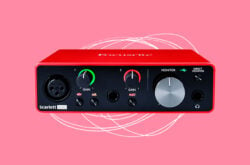Whether it’s vocals, drums, guitars, bass, or any other instruments, recording live bands for the first time can be a daunting process.
Above, Smythe from Soul Surplus showcases five production techniques that will come in handy when recording live bands—watch along for insights, and read highlights below.
1. Select the right microphones
If you have the flexibility in your studio or home setup, it’s important to understand that different microphones will have features that complement certain instruments and styles of music. “Today, we’re recording two vocalists, and I decided to use the Manley Reference Gold microphone, which is a tube condenser,” Smythe says. “The reason why I wanted to use a tube condenser is because we’re going for vintage soul, and tube condensers give you that body and that warmth that you can only get from the tubes inside of the microphone.“
“We’re also recording a drummer. For the kick drum, we’re going to use the Electro-Voice RE20, because it’s a dynamic microphone. The reason why we use a dynamic microphone on a kick drum is because it can handle the loud transients better than a condenser could.”
“For our overheads, we’re using a stereo pair of Neumann U87s, which are legendary for capturing detail—we want as much detail as we can capture from the cymbals and the toms.”
When recording live bands and individual instruments, also try thinking about how the type of mic you’re using, its polar patterns, and its other unique features can align with your creative goals. Go to 0:15 in the video to hear more on this tip, and also check out our in-depth guide on vocal microphones for even more options and insights.
2. Carefully consider mic placement
Choosing the right microphones for the job is only half the battle—where and how you place your mics is also crucial in bringing out the full potential of a band’s performance. “When miking vocalists, we like to have them stand a little bit back from the microphones to minimize proximity effect and get that vintage soul sound,” Smythe explains. “We also throw on a pop filter to get rid of plosives.”
“When miking the drums, we went with a minimal approach, only using three microphones. The two U87s have to be the same distance from the snare to get a good stereo image, and the RE20, acting as the only kick drum mic, should be a good distance from the head of the kick drum and be outside of it to get a good balance between punch and boom.”
When it comes to mic placement, note that there’s no objective right or wrong for every single scenario. However, different placements will certainly play a key role in shaping the tone of your sound, so it’s worth experimenting rigorously to get a feel for where you want to position your mics. Go to 1:30 to hear more on this tip and watch Smythe position some mics live on an array of instruments.
3. Practice proper gain staging
When using outboard gear such as pre-amps, compressors, and EQs, it can be easy for your levels to get out of hand. “What I suggest doing is setting the level on your pre-amp and making sure that it doesn’t change at all when you take your compressor in and out of bypass,” Smythe says. “That way, all you hear is the effect of your pre-amp and the effect of your compressor.”
If you don’t have access to physical outboard gear, you can still put this concept into action with high-quality software emulations like the ones found in Arturia’s FX Collection.
4. Treat your room properly
Proper acoustic treatment for your room is another factor that will come alongside mic placement and positioning to help shape your sound. “There are two main types of acoustic treatment,” Smythe says. “There’s absorption and there’s diffusion. Absorption kills the reflections in your room, while diffusion disperses the reflections to create a smooth tail.”
Go to 2:49 in the video to hear Smythe discuss the acoustics of the space he’s recording in, and check out our DIY guide on acoustic treatment to explore how you can optimize your room on a budget.
5. Promote healthy band chemistry
Whether you’re an engineer, a member of the band, or both, healthy band chemistry will lead to better energy and a more open exchange of creative ideas. “Part of the reason why Soul Surplus works so well together is that we’re actually friends outside of what we do for work,” Smythe tells us. “We’re always sharing what we’re inspired by and what we’re listening to, and it translates well sonically when it’s time to come together as a band.”
Production tips for recording live bands: Conclusion
We hope the above tips inspire new ideas and approaches for the next time you find yourself recording live bands. Do you have any questions on any of the techniques covered in the video? What sorts of topics in recording and production would you like to see us explore next? Let us know in the comments section of the video, and subscribe to the Splice YouTube channel for more tutorials.
Incorporate smooth, vintage-style recordings into your own productions with Soul Surplus’ Hollywood Soul Vol. 2:
June 12, 2023


